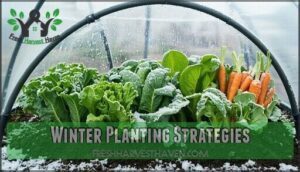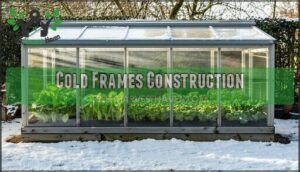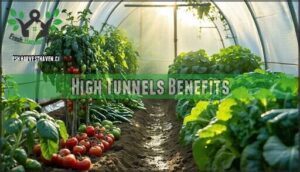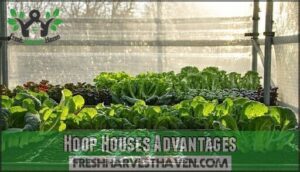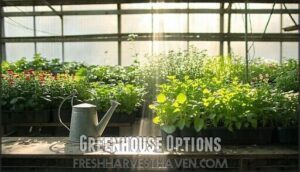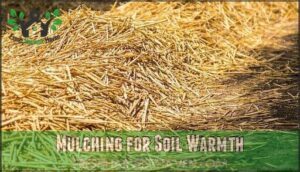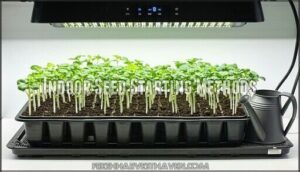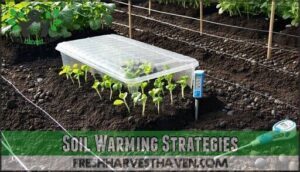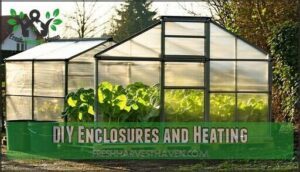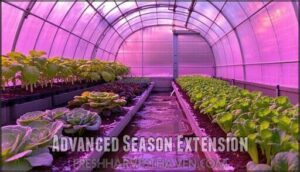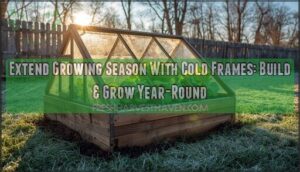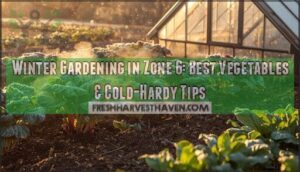This site is supported by our readers. We may earn a commission, at no cost to you, if you purchase through links.
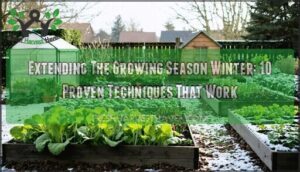
You can outsmart frost by planting cold-hardy crops like kale or carrots, wrapping beds in floating row covers, or building a simple cold frame.
Mulch acts like a cozy blanket for your soil, while high tunnels and hoop houses give your veggies a winter home.
Even tossing lettuce seeds onto snow can spark a surprise harvest.
With the right tricks, your garden won’t just survive—it’ll thrive when others are hibernating.
Curious how a greenhouse or homemade heat source can push your harvest even further?
There’s more where that came from.
Table Of Contents
- Key Takeaways
- Extending Growing Seasons
- Winter Planting Strategies
- Protective Structures Overview
- Season Extension Techniques
- Advanced Season Extension
- Frequently Asked Questions (FAQs)
- How to extend the growing season?
- What is the meaning of extended growing season?
- Can you still grow plants in the winter?
- Can climate change lengthen the growing season?
- How to manage pests during winter growing?
- When to start fall crops for winter harvests?
- Best lighting for indoor winter gardens?
- Cost-effective alternatives to commercial greenhouses?
- How to prevent disease in enclosed growing spaces?
- How to manage humidity in protected winter environments?
- Conclusion
Key Takeaways
- You can outsmart frost by planting cold-hardy crops, using row covers, and building simple cold frames to keep your harvest going through winter.
- Protective structures like hoop houses, high tunnels, and greenhouses create warmer microclimates, letting you grow fresh veggies when most gardens shut down.
- Mulch, indoor seed starting, and soil warming tricks help your plants survive cold snaps and boost soil health for better yields.
- With the right techniques, you’ll save on groceries, harvest year-round, and enjoy a wider variety of crops—even in the dead of winter.
Extending Growing Seasons
You can transform your garden into a year-round food production system by extending your growing seasons beyond the traditional spring and summer months.
This approach lets you harvest fresh vegetables well into winter while maximizing your garden space and reducing your grocery bills throughout the year.
Increased Harvest Time
While most gardeners pack it in after the first frost, you’ll be harvesting fresh vegetables well into winter with proper season extension techniques.
Don’t let frost end your harvest—outsmart winter and enjoy crisp greens while others dream of spring.
Harvest well beyond summer’s end—surprise yourself with fresh veggies while neighbors stare at snow.
Multiple cropping and succession planting create continuous harvests, extending your harvest window expansion from summer through winter.
You’ll achieve faster crop cycles by optimizing sunlight during shorter days and implementing smart winter gardening strategies. Extended availability of fresh produce means significant grocery savings year-round.
One method worth exploring is succession planting techniques for a continuous supply. The real magic happens when you master these extending growing season techniques—your neighbors will wonder how you’re still picking winter vegetables while they’re buying expensive store produce.
Cold weather crops thrive with the right approach, allowing for a continuous harvest and making the most of the winter gardening season.
Greater Variety of Crops
While traditional gardens hibernate, yours can showcase an impressive collection of winter vegetables and cold weather crops.
Season extension techniques grant access to exotic cultivars and rare heirlooms that thrive in chilly conditions.
Gourmet varieties like mizuna and tatsoi flourish when others fail, creating niche markets for creative gardeners.
- Tropical adaptations bring unexpected flavors to winter harvests
- Rare heirlooms offer unique tastes unavailable in stores
- Gourmet varieties command premium prices at farmers’ markets
- Exotic cultivars create conversation starters at dinner parties
- Crop diversity guarantees something’s always ready for harvest
Maximized Use of Garden Space
Winter doesn’t have to shut down your garden’s productivity. Maximized use of garden space transforms every square foot into a harvest opportunity through strategic planning and smart techniques.
Vertical gardening structures multiply your growing area upward, while intensive planting squeezes more crops into smaller spaces. Succession planting guarantees continuous harvests, and companion planting pairs compatible crops for maximum yields.
| Technique | Space Benefit | Winter Application |
|---|---|---|
| Vertical Gardening | Doubles growing area | Trellises for peas, beans |
| Intensive Planting | 4x more plants/sq ft | Dense leafy greens spacing |
| Succession Planting | Continuous harvest | Staggered lettuce sowings |
Season extension through thoughtful space optimization keeps your raised bed gardening productive year-round.
Enhanced Self-Sufficiency
Through season extension, you’ll discover true food independence that transforms your household economics.
Winter gardening builds resilience while seed saving creates lasting value.
- Achieve genuine food independence by harvesting fresh produce when grocery prices soar
- Master skill development in cold frame gardening and greenhouse gardening techniques
- Practice resource optimization through continuous garden productivity and reduced waste
- Embrace sustainable living by extending harvests with smart winter garden planning
- Build community knowledge through sharing proven season extension methods
Winter Planting Strategies
You can grow fresh vegetables all winter long by choosing the right crops and planting them at the perfect time.
Smart winter planting means selecting cold-hardy varieties like kale, spinach, and carrots that actually taste sweeter after frost.
Then, timing your seeds so they’re established before daylight hours drop below ten is crucial for a successful harvest.
Cool-Season Crops Selection
Your winter garden planning starts with choosing the right frost-sweetened crops that’ll thrive when temperatures drop.
These leafy green varieties actually improve after cold snaps—nature’s way of concentrating sugars for better flavor.
Sweet when frosted
Sweetens after frost
Consider your planting timeline carefully—these brassica benefits shine brightest with proper cold frame gardening techniques.
Cold-Hardy Varieties Research
Beyond selecting the right crop types, you’ll want to dig deeper into variety selection that leverages specific Frost Tolerance Mechanisms.
Winter Hardiness Traits aren’t just marketing fluff—they’re scientifically-backed Genetic Adaptations that determine your garden’s survival.
Modern Breeding Strategies have produced remarkable cold-hardy crops with enhanced sugar accumulation and cellular protection.
Collard greens now survive down to 5°F, while new spinach varieties maintain Nutritional Analysis profiles even during extended freezes.
New Zealand gardens benefit from vegetables with winter thriving varieties.
Universities continue developing varieties specifically for winter gardening success.
These aren’t your grandmother’s seeds—they’re precision-engineered for season extension performance.
Research French-American hybrids and university-released cultivars that transform your winter crops from survival mode into thriving productivity.
Self-Sowing Plants Benefits
Why let Mother Nature do the heavy lifting when you can harness her natural propagation skills?
Self-sowing plants deliver impressive cost savings while providing a reduced workload for your winter gardening efforts.
These volunteer champions boost biodiversity in your garden ecosystem, offering valuable ecosystem services year after year.
Overwintering plants like arugula and dill naturally select for cold tolerance, creating increasingly hardy populations.
You’ll discover these self-seeders often outperform their pampered, manually-planted cousins with remarkable resilience.
Lettuce Seeds on Snow
Here’s another wild card in your winter sowing arsenal: scatter lettuce seeds directly on snow.
This snow germination technique provides natural cold stratification, improving seed viability when spring arrives.
As snow melts, seeds settle into perfect soil pockets, creating beneficial microclimate effects.
You’ll get earlier harvests than traditional seed starting indoors methods.
This winter gardening hack requires zero frost protection yet delivers impressive season extension results.
Nature does the heavy lifting while you enjoy fresh greens weeks ahead of schedule.
Protective Structures Overview
You’ll need physical barriers to shield your plants from winter’s harsh conditions, and several proven structures can transform your garden into a year-round growing space.
From simple cold frames that trap solar heat to spacious high tunnels that protect entire crop rows, these protective structures create the perfect microclimate for extending your harvest well into the coldest months, allowing for a longer growing space.
Cold Frames Construction
Through careful planning and basic carpentry skills, you’ll build a cold frame that transforms your winter gardening game.
These protective structures create microclimates 10-20°F warmer than outside temperatures, making frost protection achievable for any gardener.
Your DIY plans should include these essential elements:
- Frame Materials – Use sturdy plywood or treated lumber for lasting durability
- Glazing Options – Choose transparent coverings like glass or polycarbonate panels
- Ventilation Design – Install hinged lids with adjustable positioning for temperature control
Heat retention happens naturally through passive solar heating, eliminating electricity costs.
A simple cold frame can substantially prolong the season for various plants.
Position your cold frame facing south for maximum sun exposure.
This season extension technique requires no artificial heating yet maintains consistent growing conditions for hardy vegetables throughout winter months.
High Tunnels Benefits
If cold frames are your training wheels, high tunnels are the sports car of season extension.
High tunnels let you garden in the fast lane—outpacing frost and harvesting when others have long packed up.
With high tunnels, you get a controlled microclimate that protects crops from frost, wind, and rain—boosting yield increase and crop quality.
You’ll see fewer pests, better water conservation, and healthier plants.
Thanks to these structures, you can kick off earlier harvests, stretch your season, and watch your farming income grow.
It’s a smart way to combine pest protection, season extension, and revenue growth.
Many growers find success with complete high tunnel kits for easy setup.
Hoop Houses Advantages
High tunnels offer big benefits, but a hoop house really shines when you want Yield Increase and Extended Harvest without breaking the bank.
These simple agricultural structures give you reliable Climate Control, keeping your crops safe from wind, frost, and garden pests.
You’ll see better Crop Quality and easier Pest Protection, all while enjoying flexible season extension.
Building one doesn’t require a contractor—just some DIY spirit and basic tools.
Consider browsing various hoop house kits for your project.
- Boosts protected cultivation for winter veggies
- Modular design fits any space
- Shields crops from unpredictable weather
- Supports ongoing crop protection
Greenhouse Options
If a hoop house feels like a cozy sweater, a greenhouse is your all-weather jacket.
Greenhouse materials—glass, polycarbonate, or plastic—affect insulation and light, so pick what fits your climate and budget. Good greenhouse ventilation keeps plants happy by balancing humidity and temperature.
Movable greenhouses and passive solar greenhouse designs cut greenhouse costs and boost season extension. For tech lovers, greenhouse automation offers freedom and innovation in protected cultivation.
Season Extension Techniques
You can outsmart winter by using a few clever techniques to keep your garden growing strong, even when temperatures drop.
With the right mix of mulch, indoor seed starting, soil warming tricks, and simple enclosures, you’ll be harvesting fresh produce long after most folks have packed up their tools, utilizing simple enclosures.
Mulching for Soil Warmth
Ever wondered how to keep your soil cozy when winter bites?
Mulches are your best friends for soil warmth and insulation.
Try straw, grass clippings, or black plastic mulch—each offers unique insulation methods for winter gardening.
For exceptional Heat Retention, apply mulch after a sunny day, locking in warmth.
Black plastic mulch is a champion for early planting.
Besides warmth, these Mulch Types boost Soil Health and offer simple Pest Control.
Smart Application Timing makes all the difference for healthy, productive soil.
Indoor Seed Starting Methods
Kick off your winter gardening with indoor seed starting—think of it as giving your plants a head start while snow still covers the ground.
Use a high-quality seedling soil mix and set trays under your choice of grow light types, keeping them just 2-4 inches above.
For speedy germination, try heat mats for germination temperature control. It’s important to select the right mix for healthy seedlings.
Watering techniques matter—keep soil moist, not soggy. Once true leaves appear, begin hardening off seedlings. This careful shift guarantees your indoor gardening success when you move plants outside.
Soil Warming Strategies
A few smart soil warming strategies can make all the difference when prepping your garden for spring.
Start by laying down Dark Mulch or black plastic mulch—this traps heat and boosts soil temperature, giving your seedlings a running start.
Hotbeds and organic mulch add extra Soil Insulation, locking in warmth and protecting roots.
Don’t forget to use a soil thermometer to check conditions.
Strategic Irrigation Methods help stabilize temperature, while Thermal Mass—like stones or water barrels—stores daytime heat for those chilly nights.
DIY Enclosures and Heating
If you’re tired of losing plants to frost, DIY Cold Frames and Pallet Greenhouses can be your secret weapons for winter gardening.
Add Solar Heating with gutter heat tape under a hoop house, or use brooder lamps and water buckets for extra warmth and humidity. Cold frames also trap solar heat, creating a warmer microclimate.
For quick frost protection, try these:
- Cut-bottom water jugs as mini greenhouses
- Tire windbreaks for microclimates
- Insulated Enclosures with straw bales
- Portable wheelbarrow greenhouses
- Layered row covers and low tunnels
Winterizing Structures never felt so inventive—or fun!
Advanced Season Extension
If you’re ready to take your winter gardening to the next level, advanced season extension techniques can help you grow fresh vegetables even when it feels like the North Pole outside.
With options like heated greenhouses, geothermal setups, hydroponics, and clever use of mulch or thermal mass, you won’t have to let cold weather stop your harvest.
Heated Greenhouses Options
When you’re ready to take winter gardening to the next level, heated greenhouses open the door to true year-round production.
To balance heating costs and boost energy efficiency, consider these top picks:
- Electric heaters—great for precise control in smaller greenhouses.
- Propane heaters—heat larger spaces quickly and reliably.
- Solar designs—harness free sunlight for eco-friendly warmth.
Combine insulation methods, greenhouse automation, and supplemental lighting for smart season extension.
Geothermal Greenhouses Benefits
While traditional heating can drain your wallet and the planet, geothermal greenhouses flip the script with energy efficiency and sustainable heating. By tapping into the earth’s steady underground warmth, you’ll keep your crops cozy year-round, slashing both your utility bills and environmental impact.
These systems don’t just cut CO2—they all but erase it, making your winter gardening truly green.
| Benefit | Impact | Practical Application |
|---|---|---|
| Space Savings | Maximizes limited land | Ideal for small properties |
| Enhanced Protection | Extends growing season | Shields crops in extreme weather |
| Sustainable Energy | Zero emissions | Lowers your carbon footprint |
| Temperature Regulation | Maintains ideal conditions | Boosts crop production |
| Energy Recovery | Uses earth’s heat | Delivers long-term cost savings |
Geothermal greenhouses are agricultural innovation in action—offering reliable crop protection, season extension, and sustainable farming, all with minimal fuss.
Hydroponic Systems Overview
Even when your soil is frozen solid, hydroponics keeps your garden thriving indoors.
By skipping dirt and feeding plants with nutrient solutions, you’ll discover Hydroponic Advantages like faster growth and fewer chores.
Here’s why hydroponic systems are a game changer for winter gardening techniques and year-round production:
- Accelerated growth rates (up to 50% faster)
- Water savings—use up to 90% less
- Space-saving, perfect for apartments or basements
- Total Environmental Control—dial in temperature, humidity, and Lighting Options
- No weeds—just pure indoor growing freedom
Explore System Types to match your goals. Even with supplemental lighting, understanding partial shade effects is key for optimizing yields.
Organic Mulch and Thermal Mass
When winter’s chill creeps in, mulch becomes your garden’s cozy blanket.
Layer straw, leaves, or grass clippings around your plants for exceptional Mulch Heat Retention and Soil Temperature Regulation.
As these mulches decompose, they boost soil health—a win for Sustainable Garden Practices.
Pair your mulch with Thermal Mass Materials like stone or bricks, which soak up sun by day and slowly release warmth at night.
For extra punch, try reflective mulch, bouncing light back to plants and keeping roots toasty during winter growing.
Frequently Asked Questions (FAQs)
How to extend the growing season?
Picture your neighbor picking fresh spinach in November—jealous yet?
You can do it, too.
Use row covers, cold frames, or a small hoophouse to trap warmth, block frost, and keep those veggies thriving long after summer’s gone.
What is the meaning of extended growing season?
You stretch your harvest beyond the usual dates, snagging fresh veggies before and after most folks hang up their trowels.
It’s like getting bonus rounds in gardening—more food, less waiting, and bragging rights.
Can you still grow plants in the winter?
Think of your garden as a cozy sweater for your plants—yes, you can still grow in winter.
Use row covers, cold frames, or a simple hoop house.
Cold-hardy crops like kale and carrots thrive, sweetening after frost.
Can climate change lengthen the growing season?
You’ll notice the growing season creeping longer as climate change warms things up, letting you plant earlier and harvest later.
Just remember, unpredictable weather swings can throw a wrench in your plans, so stay flexible and observant.
How to manage pests during winter growing?
Battling winter pests can feel like fighting an army with a toothpick, but you’ve got tricks up your sleeve.
Use row covers, keep plants tidy, rotate crops, and inspect often—aphids hate a gardener who won’t quit!
When to start fall crops for winter harvests?
Sow your fall crops about 10–12 weeks before your first expected frost.
This gives them time to grow before days get too short.
If you’re late, don’t worry—plants like kale and spinach can handle a little chill.
Best lighting for indoor winter gardens?
Lively LEDs light up your leafy greens best—choose full-spectrum, energy-efficient bulbs for healthy, happy plants.
Place them close, run them 12–16 hours daily, and you’ll dodge droopy seedlings even when winter’s winds whistle outside, ensuring healthy plants.
Cost-effective alternatives to commercial greenhouses?
Skip pricey greenhouses—build a simple hoophouse from PVC and plastic sheeting, or try low tunnels with row covers.
Cold frames made from old windows work wonders, too.
You’ll get warmth, protection, and bragging rights!
How to prevent disease in enclosed growing spaces?
Keep air moving with a small fan, open vents on sunny days, and avoid crowding your plants.
Water early so leaves dry quickly, and check for mold or spots—catching problems early keeps your crops happy and healthy.
How to manage humidity in protected winter environments?
Crack a vent or pop open a door on sunny days to let out excess moisture.
Space your plants well, water early, and avoid soggy soil—no one wants a greenhouse that feels like a sauna!
Conclusion
Did you know gardeners can boost harvests by up to 50% just by extending the growing season winter style?
With the right mix of cold-hardy crops, protective structures, and a bit of creativity, you’ll keep your garden productive long after frost hits.
Don’t let winter slow you down—try out these proven techniques and enjoy fresh veggies when most gardens are snoozing.
Who knew winter gardening could be so rewarding—and maybe even a little fun?
- https://www.researchgate.net/publication/222829450_Growing_Season_Changes_in_the_Last_Century
- https://www.epa.gov/system/files/documents/2021-12/30339_epa_report_climate_change_and_seasonality_v12_release_508.pdf
- https://www.pnas.org/doi/10.1073/pnas.1012490107
- https://www.sciencedirect.com/science/article/pii/S2212094715300116
- https://cdnsciencepub.com/doi/10.1139/cjps-2017-0278

